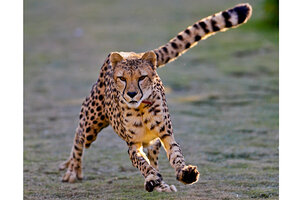Cheetahs' speed is only half the story, study finds
A study of wild cheetahs found that acceleration, agility, and maneuverability play a big role in the speedy felines' success as hunters.

A female cheetah chases a mechanized toy during a performance on the Cheetah Run at Safari Park, in Escondido, Calif., last year. New research shows that cheetah's hunting success hinges as much on the cats' acceleration and maneuverability as it does on their speed.
Lenny Ignelzi/AP
If the cheetah were a vehicle, it would have the acceleration of a Ferrari, the stopping distance of a Formula One racer, and the turning radius of a Toyota Yaris.
Most people know that the cheetah is the fastest land animal – a recent study clocked captive cheetahs at almost 65 miles per hour – but a new study has found that the African felines' swiftness is only part of the picture.
Researchers at the University of London's Royal Veterinary College affixed collars outfitted with GPS and inertial sensors to five wild cheetahs in northern Botswana, and monitored the cats' behavior for 17 months. Their study, published in the current issue of Nature, found that, in addition to their blistering speed, the cats' were also capable of some of the greatest rates of acceleration and deceleration of any land animal.
The specially developed collars, which included solar cells, accelerometers, magnetometers, and gyroscopes, precisely monitored the cheetahs' movements as they chased down their prey – usually impalas – in 367 events. The data showed that the cheetahs tended to be a bit slower than their captive counterparts: the top speed recorded was 58 mph, and the average top speed was just over 30 mph.
But what proved to be remarkable was the cats' rapid stops, starts, and turns: The cheetahs accelerated and decelerated at twice the rate as the fastest greyhounds and the best-performing polo horses, both animals that have been specifically bred for their agility. When they turned, the animals experienced centripetal acceleration of more than 1.3 times force of gravity.
“We have always thought of cheetahs as sprinters, but now it looks as though sprinting is only part of the story,” said Alan Wilson, the study's lead author, in a Nature press release.

